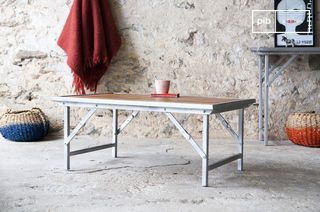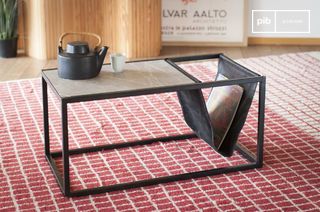Grey coffee tables
Gray coffee tables offer a neutral visual base that facilitates the balance between light furnishings and darker elements. Whether in stained wood, painted metal or composite concrete, they fit into a variety of configurations without dominating the space. Here, gray acts as a contrast regulator, capable of structuring the center of the living room without overloading. A gray coffee table sets the composition while leaving room for the surrounding materials and volumes. This type of table is equally suited to sober atmospheres and more fragmented arrangements. read more >
Filters

Functions and uses of a gray coffee table
The coffee table is a focal point in the living room, as much for circulation as for the organization of everyday objects. In this context, a gray coffee table plays a chromatic balancing role. Its visual neutrality stabilizes an often heterogeneous ensemble of sofas, armchairs, lighting and textiles in a variety of hues. Gray doesn't draw attention, but creates a subtle cohesion by linking the elements present in the space.
On a daily basis, the gray coffee table serves as a supporting surface. It holds remote controls, books, glasses or meal trays. It can also be used to organize shared moments: aperitifs, games, informal discussions. Grey can also be chosen for practical reasons. Unlike white, it is less likely to show signs of ageing. Unlike black, it doesn't dampen reflections or dust. It is therefore a sober, durable option in a living room that is actively used.
Typologies, formats and materials available
There are several families of gray coffee tables, whose differences lie in materials, formats, structures and surface finishes. Tops can be made of painted wood, lacquered MDF, waxed concrete, reconstituted stone or stained metal. Each material gives the gray a different texture: smooth and homogeneous in the case of lacquer, porous and nuanced in the case of concrete, satin on powder-coated metal. The same shade can thus produce very distinct visual effects depending on the substrate.
Shapes are also important to consider: - Round models facilitate circulation, particularly in compact rooms. - Square or rectangular formats frame more space and pair well with dangle or large sofas. - Nestable or nesting versions allow you to adapt the usable surface area to suit the moment. Some models feature a contrasting effect: a light gray top on a black base, or vice versa. Others adopt a uniform tone-on-tone look. The choice depends on the desired effect: to create a visual break or, on the contrary, to extend the existing palette.
Logic of arrangement and overall coherence
The introduction of a gray coffee table into a living room is based on a logic of composition. Its role is not to capture attention, but to ensure the legibility of the whole. In a space already rich in materials or colors (patterned carpets, textured curtains, printed cushions), gray provides a temporal effect without impoverishing. In a more streamlined setting, it avoids the visual coldness of pure white or the density of solid black.
The gray coffee table acts as a structuring base. It can echo other elements of the room: window frame, armchair base, metal suspension, charcoal gray textiles. It can also deliberately contrast with warm woods (walnut, honey oak) or more colorful touches (terracotta, deep blue, olive green). The aim is not to unify, but to balance.
It's important to think about the free space around the table. A minimum distance of 40 cm between the table and the seats ensures comfortable circulation. If the room is small, a coffee table with an open or perforated base will reduce the impression of mass. If the space is large, a wider or lower tabletop can give visual ease to the overall composition.
Lighting, accessories and durability
Gray interacts with light in different ways depending on its finish. A matte top absorbs more ambient light, creating an impression of softness. A satin or polished surface returns light diffusely, without excessive shine. These choices have a direct impact on the perception of volume, especially in the presence of multiple light sources (floor lamps, wall lights, natural light). It is therefore useful to observe the rendering of grey in the room before purchasing.
Finally, the grey coffee table lends itself well to the addition of complementary objects: vases, books, trays, candles. Their presence should be thought of not as an overload, but as an extension of the furnishings. Natural materials (rattan, ceramics, transparent glass) blend effortlessly. Gray doesn't neutralize objects: it puts them in order.
Opting for a gray coffee table means choosing a discreet yet structuring piece of furniture. It doesn't seek to impose, but to organize space with coherence. It offers great design flexibility, visual stability and broad compatibility with today's interior styles.


